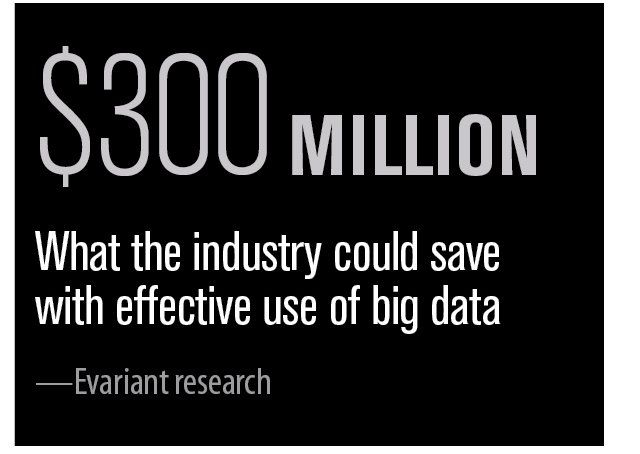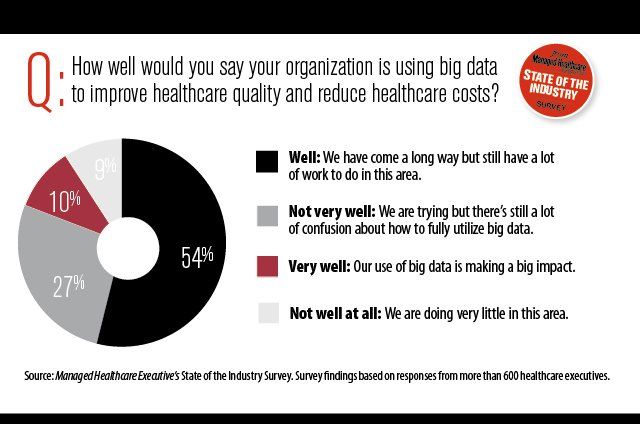Making sense of big data: Data projects spur progress
Many health systems have a hard time capturing and using data from patients that can make a real impact on their businesses. Here are some innovative projects to have on your radar.
The use of data in healthcare has been hailed as a solution for saving time and dollars and improving patient outcomes for a healthcare organization. However, many health systems have a hard time capturing and using data from patients that can make a real impact on their businesses.
Part of the issue lies in electronic health record (EHR) data, which can provide an incomplete picture of patient behavior, according to a study recently published in the Journal of the American Medical Informatics Association. EHRs are inadequate in capturing mental health diagnoses, visits, specialty care, hospitalizations, and medication, according to the study by the Harvard Pilgrim Health Care Institute.

For example, when behavioral healthcare is administered off site, EHRs can miss large amounts of data, which can lead to overprescribing and missed diagnoses. EHRs missed 89% of data for acute psychiatric services, and for those receiving less than two weeks of outpatient care for depression or bipolar disorder, 60% and 54% of care, respectively, according to the study.
“Recent massive investment in EHRs was predicated on the assumption of improved patient safety, research capacity, and cost savings. However, most U.S. health systems and health records are fragmented and do not share patient information,” the study’s authors say.
When big data can be used holistically to revamp healthcare processes including care coordination, patient relationships and financial services, the results can save organizations thousands of dollars and a lot of hours.
According to research by Evariant, the effective use of big data in healthcare could save the industry $300 million a year. Analysis of real-time data saved one hospital $850,000 in overtime costs, with more intelligent discharge planning, disease management, quality assurance, and performance reporting, according to Evariant.
However, it has been difficult for healthcare providers to integrate EHR data with clinical transcripts and other notation that would add context to patient care. According to a 2015 eHealth Initiative survey, only 17% of providers have been able to couple population health analytics with EHR data.
Due to these data constraints, healthcare organizations have been partnering with technology organizations to make health records more complete, and increase patient engagement in the care coordination process.
Next: Enhancing the record
Enhancing the record
In April, the Patient-Centered Outcomes Research Institute (PCORI) funded 21 patient-centered clinical research studies to look at using data to improve care for cancer, antibiotic misuse, post-partum depression, post-traumatic stress disorder among veterans, and joint replacement, along with other conditions.
“We believe these studies will address significant gaps in our knowledge and have the potential to change practice and improve patients' outcomes,” says Joe Selby, MD, MPH, executive director of PCORI.
The latest round of PCORI funding totals $44.4 million-in total the nonprofit organization has funded more than 500 patient-centered studies totaling $1.3 billion since 2012.

HernandezAdrian F. Hernandez, MD, MHS, director of outcomes and health services research, Duke Clinical Research Institute, and co-principal investigator for PCORI, works with the PCORI-funded PCORnet initiative, which aims to leverage data accumulated through EHRs, uniting patients, health systems and researchers.
“The key question is how to leverage data and increase engagement in an effective and less-expensive way. There are tons of redundancies to address and unanswered questions when it comes to healthcare data,” Hernandez says.
PCORnet is made up of 29 healthcare systems that partner with patients to create more complex clinical research trials. Approximately 75 million patients of diverse backgrounds, health conditions and ages have been part of the PCORnet data study, which started in 2014. The data feature nearly 60 million records that include more than five years of observational data.
One example of how the data will be applied is a three-year clinical study that will monitor aspirin dosing in patients with heart disease to prevent strokes and heart attacks. The study will be called a pragmatic trial, because the research will be done in a normal healthcare setting and will affect a broad group of people. “Research has been a separate part of the healthcare process. We want to make a way to make sure that it is integrated into routine care and not added to care,” Hernandez says.
PCORI also built an infrastructure to help health systems convert EHR data into a common language, and aggregate results to paint more meaningful profiles of patients. The latest round of funding will allow for research organizations to observe the data and create care delivery models that include more robust patient information.
“If you can imagine how fragmented the healthcare system is, this is a big accomplishment in a short period of time, but there is much more work to do,” says Hernandez. “Having data alone is not enough to help patients and change lives.”
Next: Providing a more complete picture
Providing a more complete picture
The Montefiore Medical Center in Bronx, New York, has partnered with Franz, Inc., Intel, Cloudera, and Cisco to transform statistical databases, such as spreadsheets, into interactive graph databases that can be used to make better informed and predictive healthcare decisions.

Aasman“If you are in a hospital and have millions of patients, you will need to do analytics in many ways-for more personalized medicine, for predictive modeling, and for better business intelligence,” says Jans Aasman, PhD, CEO of Franz, Inc., which specializes in semantic web technologies. “This system allows you to get all the data together from these different silos for analytics.”
Semantic data lakes (SDLs) enable healthcare providers to use multiple types of data sets congruently to get a more comprehensive picture of population health trends, says Parsa Mirhaji MD, PhD, associate professor of Systems and Computational Biology and director of Clinical Research Informatics at the Albert Einstein College of Medicine and Montefiore Medical Center-Institute for Clinical Translational Research.

Mirhaji"The ability to conduct real-time analysis over new combinations of data such as patient information, genetic data, medical device data, clinical trials, drug information and public health data-will fuel discoveries, significantly improve efficiencies and personalize care," Mirhaji says. “Smarter and more intelligent data and analytics opens the door for building analytic machines that can behave as if they understand the data and can think cohesively about the problem at hand using the data. This is called cognitive computing, similar to IBM Watson.”
The multidimensional data project used at Montefiore is expected to grow by trillions of data points in 2016. The hospital uses SDLs to bring together EHR data with data about health trends in a particular region and other clinic information so that practitioners can see links between health conditions. The researchers say that the platform could be available wide-scale in healthcare in the next five years.
"Making sense out of big data is a challenge, particularly in the healthcare industry where information comes from a variety of sources and in different forms including structured, unstructured, images, temporal, geo-location and signal data,” Aasman says. “With the SDL for healthcare we quickly ingest many types of data into a single system and apply artificial intelligence, machine learning and visual data exploration to discover new relationships between data that can save lives and improve care.”

Donna Marbury is a writer in Columbus, Ohio.
In the Scope of Virtual Health and the Future of “Website” Manner, Per Ateev Mehrotra
August 10th 2023Briana Contreras, an editor of Managed Healthcare Executive, had the pleasure of catching up with MHE Editorial Advisory Board Member, Ateev Mehrotra, MD, MPH, who is a professor of healthcare policy at Harvard Medical School and an Associate Professor of Medicine and Hospitalist at Beth Israel Deaconess Medical Center.
Listen
Extending the Capabilities of the EHR Through Automation
August 2nd 2023Welcome back to another episode of "Tuning In to the C-Suite," where Briana Contreras, an editor of Managed Healthcare Executive, had the pleasure of chatting with Cindy Gaines, chief clinical transformation officer at Lumeon.
Listen